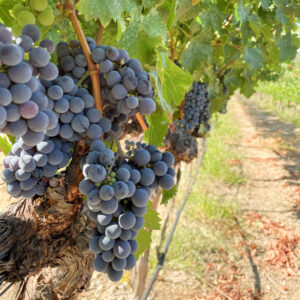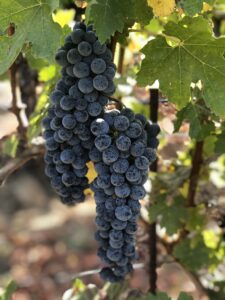Did you know that Cab Franc grape is one of the parents of Cabernet Sauvignon, along with Sauvignon Blanc?
Nearly 70% of Americans drink red wine the majority of the time. This is a broad category that encompasses many different varieties, including Cabernet Franc and Cabernet Sauvignon, among others.
Each type of red wine brings its own flavor profile, complexity, and character to the table. At Majuscule Wines, we make Cab Franc and Cab Sauvignon. While the two grapes might sound similar, they’re not the same. So what is Cab Franc and how does it differ from the ubiquitous Cabernet that everyone knows? Let’s break down the distinctions so you can buy wine online in confidence.
What Is Cab Franc?

Cab Franc is a red wine grape that grows in the Loire Valley of France and in other regions including the United States, Canada and South America. Did you know that Cab Franc grape is one of the parents of Cabernet Sauvignon, along with Sauvignon Blanc? It’s also one of the five Noble Grapes of Bordeaux: Cabernet Sauvignon, Merlot, Cabernet Franc, Malbec, and Petit Verdot.
While it’s often used to blend with other varietals in Bordeaux-style red wines, Cab Franc makes a stunning single-varietal red wine or a very memorable rosé. We’ve made both styles at Majuscule.
As a red wine, Cab Franc is medium-bodied with moderate tannins. The flavors are defined by a balance of red fruits, herbs and peppery earthiness. It has a medium acidity that makes it refreshingly easy-to-drink and incredibly versatile for pairing with a variety of foods.
What is Cabernet Sauvignon?

One of the most popular wines in the US and the world is Cabernet Sauvignon. It’s a full-bodied red wine that typically boasts high tannins and robust flavors. Like Cab Franc, it has a dark color and contains notes of dark fruits and tobacco. However, it also has a creamier and spicier finish, with distinct aromas of vanilla, spice, chocolate and oak obtained during the aging process.
In the Napa Valley’s warm climate, the fruit can fully ripen and become full-bodied, whereas it tends to remain smaller and more structured in cooler climates like Bordeaux.
Cab Franc vs Cabernet Sauvignon
While they share some similarities, Cab Franc and Cabernet Sauvignon also have a few notable differences. These include:
-
- Tannin volume: High for Cab Sauv, low for Cab Franc
-
- Body: Full-bodied for Cab Sauv, medium-bodied for Cab Franc
-
- Flavor profile: Savory for Cab Sauv, fruit and sweet for Cab Franc
-
- Growing climate: Warm for Cab Sauv, cooler for Cab Franc
-
- Taste: Deep and bold for Cab Sauv, lighter and softer for Cab Franc
Taste the Differences: Buy Wine Online Today
In the showdown between Cab Franc and Cabernet Sauvignon, there isn’t a clear-cut winner. Rather, each stands on its own for many reasons and personal preferences. We recommend trying both side by side to experience the differences and similarities so you can decide. You just might like both equally!
From our portfolio we recommend our 2021 Mount Veeder Cab Franc – it’s gracious and supple with a balanced acidity and tannin structure – and our 2019 Mount Veeder Cabernet Sauvignon, which has concentrated flavors of blackberry, cherry and cranberry with well-integrated tannins, beautiful acidity and a hint of minerality.

